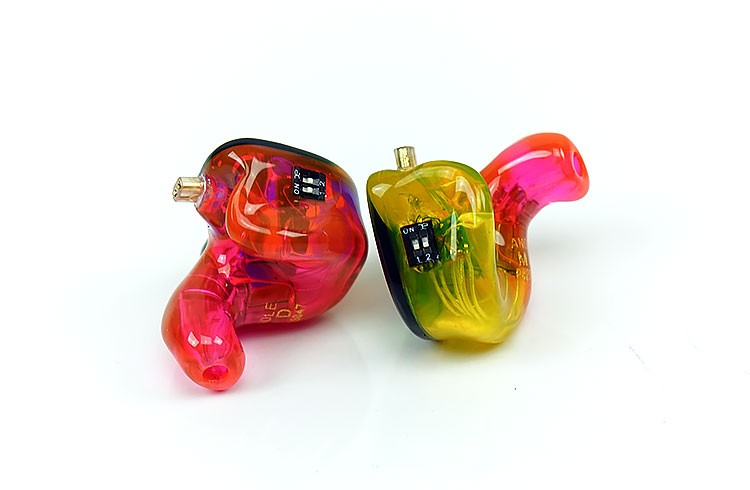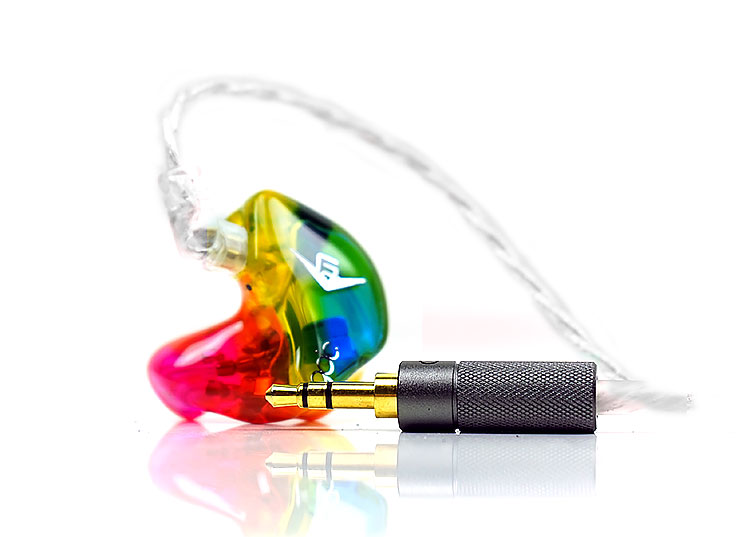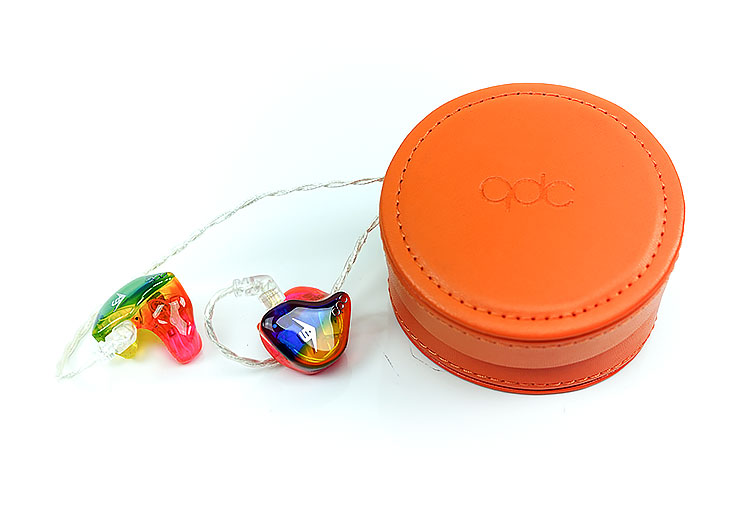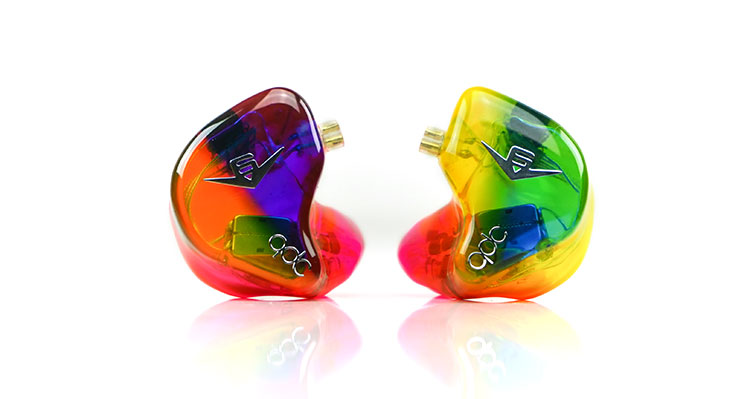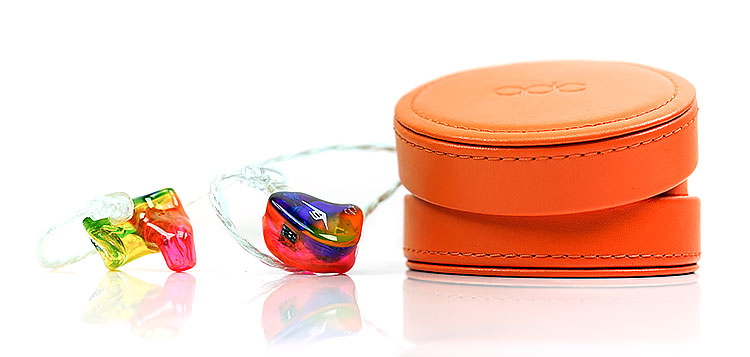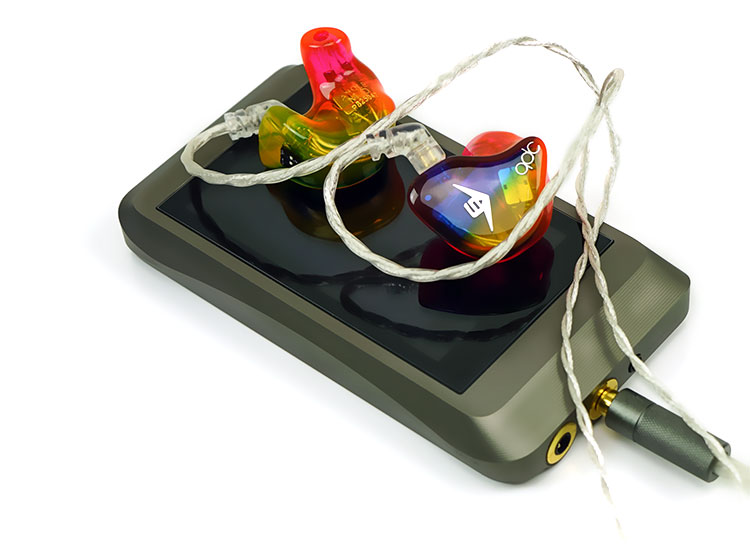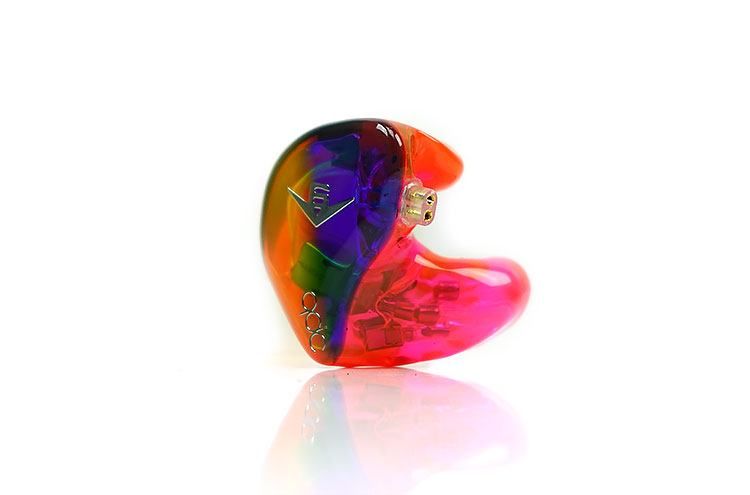Meet the Anole V6-C
Design
Whatever issues I have with the online store process I can safely say the final product is deliciously loud-looking and built to an incredibly high standard.
The Magic color effect really has some fantastic pop in the studio for pics taking. Sure, it might not be to everyone’s tastes but everywhere I have taken it people notice it right away. You cannot miss it. I am a fan of loud colors and ‘candy designs’ of late and the Anole V6-C design is all that and some more.
But beyond the subtle blends of colors, and something I am not sure the pics can easily pick up on unless I go macro, is the finish, especially around the switches on the sides. There is not a bubble or ripple anywhere on the shell right up to the switch enclosure.
I was half expecting to have a few issues here since it is a manual insertion such as a tiny kink or two but nope, nothing. The seal is immaculate and the switches, small they might be, are very clean and easy to read. You will need a small tool to move the switches though. Even fingernails might not be enough because they are quite flush to the body.
Materials
The Magic Color edition is an all-acrylic finish for both the faceplate and shell. I believe it is a hollow acrylic build with no additional silicone fill. The qdc logo and banner seem to be small cutouts inserted just beneath the main plate rather than imprinted directly onto them.
The black switch box is just under the main shell on the sides with the main switch top plate accessible though as mentioned it’s quite flush and you need a tool to move them easily.
Internals
The Shells are translucent so you can peer right into the internal build which I always find interesting. The switch is actually quite a distance from the balanced armatures with the crossover board all just underneath the connectors. The wiring has virtually no overlap and really looks like one well-arranged layout. This soothes my OCD.
qdc is using 4 small and 2 larger balanced armature drivers for the Anole V6-C. It would seem the internal arrangement has all the drivers quite close to the nozzle with a triple-bore tube exit into a horn design exit.
Horn Design Bore
The bores on the qdc are terminated much deeper into the chamber of the nozzle and not right on the tip of the nozzle. This termination point is where the “horn design” essentially starts on the Anole V6-C.
The large open bore allows qdc to fine-tune and develop the readily mixed sound before it leaves the chamber and into the bore. In doing so, they are able to tweak the Anole V6-C’s high-frequency extension a little further than what is possible with a traditional individual tubed bore design using the same drivers.
Cables & Connectors
Ok so here is the tricky part with the qdc Anole V6-C. If you are happy with the stock cable or one of the cables provided in your checkout then it will not be an issue. For those that like to swap cables and have high-performing ones the design of the connectors (and jack) will present issues.
Protruding Sockets
The issue is two-fold. First, the connector stems on the Anole V6-C shell are protruding designs. This is a design I have seen before with Unique Melody customs and in all honesty, I do find them stronger and more comfortable with the cable connectors angled to gently guide the cable around the ear.
However, unless you specifically have that type of connection on your aftermarket cable the resulting connection with a regular 2-pin design loses a lot of strength and sticks out a fair bit.
Reverse Polarity
This is not an unworkable scenario if you are really determined. The second problem is where it gets super messy as the pins are reversed polarity as is the entire cable-to-connector design. That means any regular cables have to be connected with the pins “upside-down”. Combine that with protruding connections and it becomes a nightmare.
Stock Cable
qdc has packaged the Anole V6-C with a 4-core silvering copper wire wrapped in a translucent PVC jacket around 1.2m in length. The stock termination is a 3.5mm TRS gold-plated jack with a matching aluminum alloy jack and y-split barrels. Both barrels have a nice grippy texture to the rear which helps a lot with handling.
The cable is quite light and very easy to work with meaning pliant and tangle-free. You will not find much in the way of physical noise or microphonics in the wire either.
There is a longish memory wire at the base of the connectors but it’s super soft, hardly noticeable, and physically moves with your ear shape then snaps back after rather than you have to shape it yourself.
This is a cable really to get you going rather than optimal performance. It is relatively warm sounding and to be honest, I think adds a little to the charm of the V6-C’s euphonic timbre. If you like that tuning warm and rich and relatively laid-back then stick with the stock cable.
Aftermarket Cables
I personally managed to find a way to stick some monster cables on the Anole V6-C without too much discomfort. Plussound’s new Tri-Silver X8 did open up the presentation substantially with a very holographic soundstage but also delivered a much more neutral sound that I am not sure works with the V6-C’s meatier tuning.
What really worked for me was the Effect Audio Janus Dynamic which had a slightly more traditional hi-fi-like soundstage but much better low-end texture which suits the V6-C’s more musical tuning.
If the budget is a bit tighter then the OC Studio Orpheus MK-5 at approx $250 is one killer 8-wire copper cable for the Anole V6-C’s. You get a nice meaty low-end and plenty of dynamic range. You lose a bit in absolute clarity compared to the Janus or Tri-Silver but the rich and euphonic timbre is just right.
Comfort & Seal
Relaxed Fitting
qdc seems to be advocates of a slightly relaxed fitting for the Anole V6-C. I am not sure if they follow that philosophy with their Live series for stage musicians where I generally like to think the nozzle would be much longer.
In the case of the Anole V6-C, a relaxed fitting means a slightly short nozzle that doesn’t penetrate too far down your ear canal. With the horn design, it does mean a lot of the signal is mixed in the nozzle and first part of the ear canal rather than being delivered directly beyond the second bend.
A relaxed fitting may not be ideal for a very active lifestyle but it is incredibly comfortable for sitting on your backside listening to music for very long listening sessions. This is probably one of the most comfortable fits I have had to date and certainly up there with the likes of Vision Ears and Custom Art.
Seal
The nozzle on the Anole V6-C does not need to be as 100% accurate or as detailed as 64 Audio’s designs since they use far deeper nozzle inserts to achieve their seal.
For example, the 64 Audio A6 feels a little more secure and certainly extends a lot further than the V6-C so the perception is of a better seal. However, they both have equal amounts of passive isolation and block out background noise very impressively.
Compared to Empire Ears the fit on their Phantom is just a little bit tighter with more pressure on the ear canal. However, the passive noise isolation is actually a little bit better, particularly for low-frequency hum-like air-cons which are almost 100% blocked out for me.
Sound Impressions
Summary
The Anole V6-C is a U-shaped, natural to slightly warm-sounding presentation with a healthy sub-to-mid bass elevation, a strong and forward vocal presence, and a fairly relaxed but still quite airy-sounding treble performance.
That’s the dry description because the Anole V6-C is so much more than that. The first time I heard it at CanJam Singapore in 2018 I was gripped by the tuning and just how perfect it was for about 90% of what I listen to, be it a strong vocal, a guttural lower-mid guitar chord, or some anthemic synth-wave richness.
Roll on 10 months and whilst I wouldn’t disagree that there are technically more capable or resolving monitors, the V6-C is perhaps the most balanced tuning I have heard to date in terms of just pure enjoyment.
This is a smooth sound with more than its fair share of euphonic overtones but it has all the bumps in the right places that bring music alive for me in a way the Final D8000 did at a headphone level.
What particularly impresses me the most about the Anole V6-C is the strength of the vocal delivery. It is a decidedly forward yet very natural-sounding pitch for both male and female vocal pitching.
In fact, the whole 1-4k range is pumped up on the Anole V6-C but you will be hard-pressed to hear an edgy or sibilant tone. These drivers hardly break a sweat in delivering a real virtuoso vocal performance.
Four Flavors
And my goodness you get four flavors of this engaging signature that even then never seems to tip the balance of the V6-C’s core performance. Everything seems tastefully done with each signature from a stronger bass that never overpowers the mids and treble to an almost Vision Ears VE5-like smooth vocal alternative with lush full-bodied lower mids.
The only peculiar one is the High Sensitivity setting which seems to increase the gain across the board and perhaps tweak a little more treble energy in the sound.
For treble lovers, there is not really enough of it but it does produce some more exciting contrast to the even harmonic emphasis in the strong bass and smooth vocal alternatives.
Staging
The Anole V6-C exhibits excellent depth for an all-BA design. You won’t find gut-wrenching power and it will not hit the heights of say Layla’s vast subterranean-like sub-bass delivery but its presence can be felt and it definitely adds to the impressive PRaT and bass fundamental in much of its instrumental timbre.
The lower-mids scoop and big jump from 1-4k will position most instrumental imaging behind vocal presence so it’s a reasonably intimate stage but one with excellent instrumental separation and strong imaging. Height is on the average side and it does begin to roll off beyond an 8k peak.
I actually never found it to lack air or headroom and far less dark-sounding compared to the likes of the 64 Audio A6. Call this more of a live concert feel than a vast arena-like precision experience.
Modes
Standard
Out of the box with both switches down you get the default sound signature or standard mode. It is likely you will be using this signature for about 60-80% of your listening as it is the most balanced sounding of the four.
This is pretty much the summary described above with a BA-style low-end delivery that’s punchy without sounding bloated or overly warmed up, a slight lower-mid scoop, and a killer vocal delivery.
The emphasis is on a natural but very balanced-sounding listening experience. The timbre is reasonably euphonic but with a mids boost and upper harmonic order presence that retains a really nice level of clarity and openness for those vocals to breathe and shine.
Strong Bass
The strong bass switch retains more or less the same response curve from 1k onwards and instead elevates the 20Hz to 200Hz range by around 4-5dB. You will get a little more sub-bass presence and power as well as some mid-bass warmth but nothing overly cooked.
I do love the bass definition on this setting because there does seem to be there is more of a nod to pushing up the sub-bass response than huge dollops of mid-bass warmth. Thus, whilst it is more low-end dominant, it never seems to lose control or become annoyingly flabby and soft.
Lower-mid high-impact guitar work will sound a little more authoritative and even lower-pitched kick drum work sounds more physical with more body. You do lose a little mids clarity and treble presence though they do not so much diminish but rather resonate a little less as the balance takes on more bass bias.
I tend to switch to the bass mode if I am listening to more instrumental rock and synth-wave tracks where vocal presence is less of an ingredient.
That being said vocal clarity on the Anole V6-C, both male and female, still sounds fantastic with excellent harmonic balance. H.E.A.T’s Erik Grönwall’s incredible vocal range on masterful tracks such as Redefined still sounds incredibly natural on the strong bass setting. It is just not the center of focus.
Smooth Vocal
The smooth vocal is my guilty pleasure, for when I just want to go my ‘dark side’ and push vocals out, way out. That being said the smooth vocal does a little more than that to keep the tonal balance relatively coherent sounding.
Compared to the standard mode the lower-mids start elevating from 500Hz rather than 1K and the strong bass sub-bass bias drops back to a shade lower than the standard mode.
As a result, you lose a little bit of impact and depth but in return, you get a bit more instrumental presence and warmth and a forward vocal presence that is creamy smooth for both male and female styles.
There is also less of an upper-mids 4k dip I tended to find on both strong bass and standard settings so percussion presence is also a little more forward and energetic sounding. That additional upper-mid and lower treble help to offset that 500Hz boost and prevent it from sounding overly lush sounding.
High Sensitivity
Now two things happen here for me in high sensitivity mode. First, the V6-C does indeed become more sensitive to gain and volume levels and you do have to drop the volume down a small amount to match with the other settings.
You also get a bit more treble presence and sparkle but it is not a peaky or harsh sound, rather just a smidgen more forward and draws your attention a little more to the upper mids onwards on the Anole V6-C.
The low-end response returns to something like the standard setting so a bit of that lower-mid warmth from the smooth vocals drops and you get a more neutral-sounding timbre with a little more of an odd harmonic overtone.
Those who like their percussion a bit more energetic and a cleaner ‘edge’ to plucked strings will go for the high sensitivity setting. Certainly, I appreciated the additional “crunch” in metal guitar work with this setting.
Click on Page 3 below for recommended pairings and selected comparisons.


